wheel PORSCHE 911 GT2 2010 5.G Information Manual
[x] Cancel search | Manufacturer: PORSCHE, Model Year: 2010, Model line: 911 GT2, Model: PORSCHE 911 GT2 2010 5.GPages: 35, PDF Size: 3.73 MB
Page 6 of 35
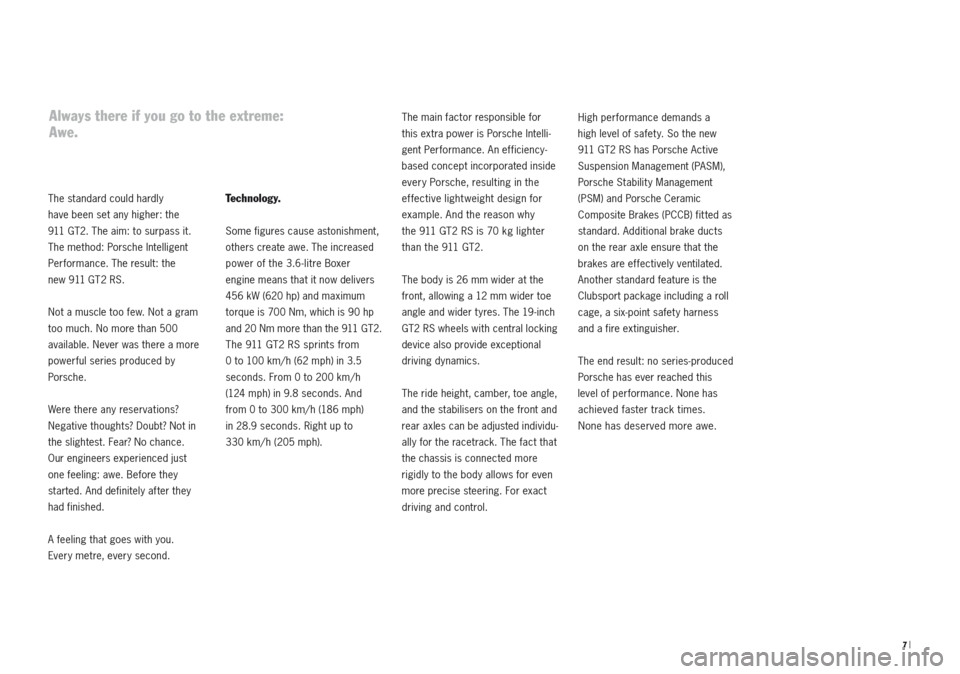
7 |
The standard could hardly
have been set any higher: the
911 GT2. The aim: to surpass it.
The method: Porsche Intelligent
Performance. The result: the
new 911 GT2 RS.
Not a muscle too few. Not a gram
too much. No more than 500
available. Never was there a more
powerful series produced by
Porsche.
Were there any reservations?
Negative thoughts? Doubt? Not in
the slightest. Fear? No chance.
Our engineers experienced just
one feeling: awe. Before they
started. And definitely af ter they
had finished.
A feeling that goes with you.
Every metre, every second.
Te c h n o l o g y.
Some figures cause astonishment,
others create awe. The increased
power of the 3.6-litre Boxer
engine means that it now delivers
456 kW (620 hp) and maximum
torque is 700 Nm, which is 90 hp
and 20 Nm more than the 911 GT2.
The 911 GT2 RS sprints from
0 to 100 km/ h (62 mph) in 3.5
seconds. From 0 to 200 km/ h
(124 mph) in 9.8 seconds. And
from 0 to 300 km/ h (186 mph)
in 28.9 seconds. Right up to
330 km/h
(205 mph).
The main factor responsible for
this extra power is Porsche Intelli-
gent Performance. An efficiency-
based concept incorporated inside
every Porsche, resulting in the
ef fective light weight design for
example. And the reason why
the 911 GT2 RS is 70 kg lighter
than the 911 GT2.
The body is 26 mm wider at the
front, allowing a 12 mm wider toe
angle and wider tyres. The 19-inch
GT2 RS wheels with central locking
device also provide exceptional
driving dynamics.
The ride height, camber, toe angle,
and the stabilisers on the front and
rear axles can be adjusted individu-
ally for the racetrack. The fact that
the chassis is connected more
rigidly to the body allows for even
more precise steering. For exact
driving and control.High performance demands a
high level of safety. So the new
911 GT2 RS has Porsche Active
Suspension Management (PASM),
Porsche Stability Management
(PSM) and Porsche Ceramic
Composite Brakes (PCCB) fitted as
standard. Additional brake ducts
on the rear axle ensure that the
brakes are effectively ventilated.
Another standard feature is the
Clubsport package including a roll
cage, a six-point safety harness
and a fire extinguisher.
The end result: no series-produced
Porsche has ever reached this
level of performance. None has
achieved faster track times.
None has deserved more awe.
Always there if you go to the extreme:
Awe.
Page 7 of 35
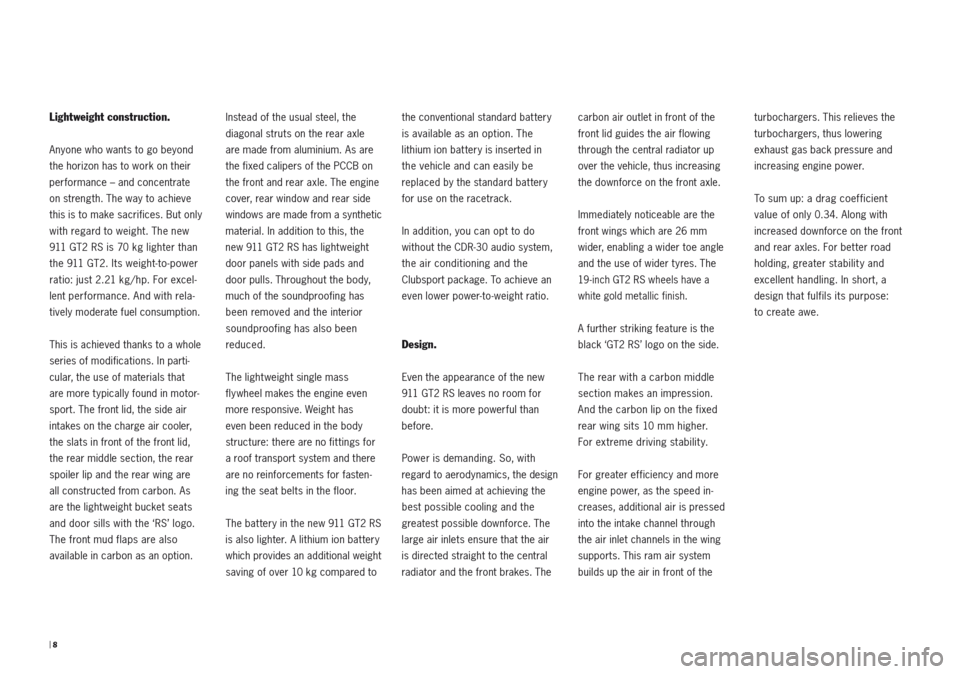
| 8
carbon air outlet in front of the
front lid guides the air flowing
through the central radiator up
over the vehicle, thus increasing
the downforce on the front axle.
Immediately noticeable are the
front wings which are 26 mm
wider, enabling a wider toe angle
and the use of wider tyres. The
19-inch GT2 RS wheels have a
white gold metallic finish.
A further striking feature is the
black ‘GT2 RS’ logo on the side.
The rear with a carbon middle
section makes an impression.
And the carbon lip on the fixed
rear wing sits 10 mm higher.
For extreme driving stability.
For greater efficiency and more
engine power, as the speed in-
creases, additional air is pressed
into the intake channel through
the air inlet channels in the wing
supports. This ram air system
builds up the air in front of the
Lightweight construction.
Anyone who wants to go beyond
the horizon has to work on their
performance – and concentrate
on strength. The way to achieve
this is to make sacrifices. But only
with regard to weight. The new
911 GT2 RS is 70 kg lighter than
the 911 GT2. Its weight-to-power
ratio: just 2.21 kg/ hp. For excel-
lent performance. And with rela-
tively moderate fuel consumption.
This is achieved thanks to a whole
series of modifications. In parti-
cular, the use of materials that
are more typically found in motor-
sport. The front lid, the side air
intakes on the charge air cooler,
the slats in front of the front lid,
the rear middle section, the rear
spoiler lip and the rear wing are
all constructed from carbon. As
are the lightweight bucket seats
and door sills with the ‘RS’ logo.
The front mud flaps are also
available in carbon as an option. Instead of the usual steel, the
diagonal struts on the rear axle
are made from aluminium. As are
the fixed calipers of the PCCB on
the front and rear axle. The engine
cover, rear window and rear side
windows are made from a synthetic
material. In addition to this, the
new 911 GT2 RS has light weight
door panels with side pads and
door pulls. Throughout the body,
much of the soundproofing has
been removed and the interior
soundproofing has also been
reduced.
The lightweight single mass
fly wheel makes the engine even
more responsive. Weight has
even been reduced in the body
structure: there are no fittings for
a roof transport system and there
are no reinforcements for fasten-
ing the seat belts in the floor.
The battery in the new 911 GT2 RS
is also lighter. A lithium ion battery
which provides an additional weight
saving of over 10 kg compared to the conventional standard battery
is available as an option. The
lithium ion battery is inserted in
the vehicle and can easily be
replaced by the standard battery
for use on the racetrack.
In addition, you can opt to do
without the CDR-30 audio system,
the air conditioning and the
Clubsport package. To achieve an
even lower power-to-weight ratio.
Design.
Even the appearance of the new
911 GT2 RS leaves no room for
doubt: it is more powerful than
before.
Power is demanding. So, with
regard to aerodynamics, the design
has been aimed at achieving the
best possible cooling and the
greatest possible downforce. The
large air inlets ensure that the air
is directed straight to the central
radiator and the front brakes. The turbochargers. This relieves the
turbochargers, thus lowering
exhaust gas back pressure and
increasing engine power.
To sum up: a drag coefficient
value of only
0.34. Along with
increased downforce on the front
and rear axles. For better road
holding, greater stabilit y and
excellent handling. In short, a
design that fulfils its purpose:
to create awe.
Page 11 of 35
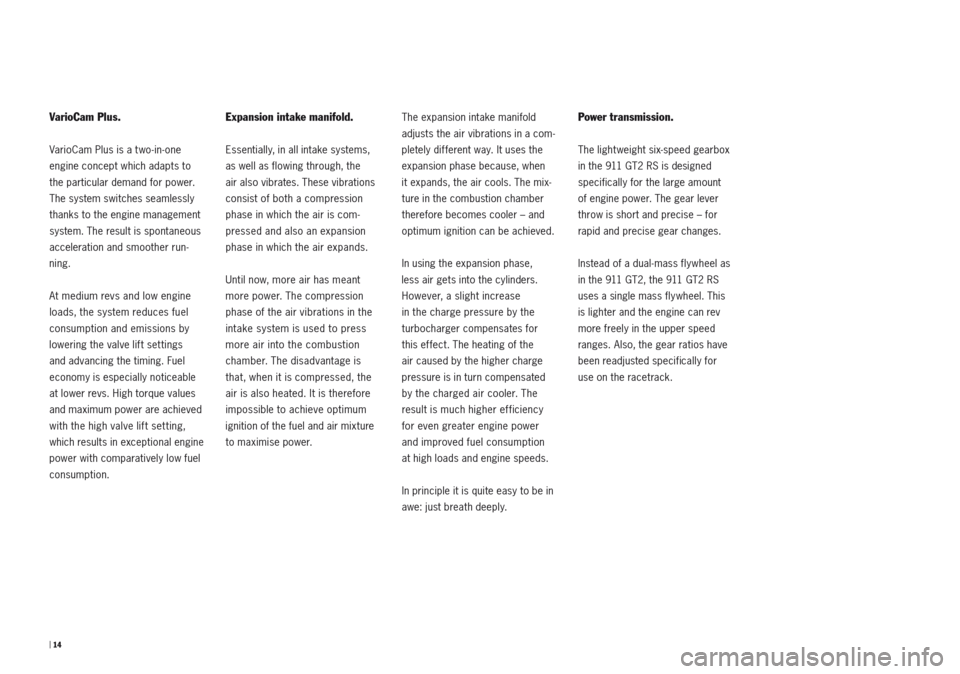
| 14
VarioCam Plus.
VarioCam Plus is a two-in-one
engine concept which adapts to
the particular demand for power.
The system switches seamlessly
thanks to the engine management
system. The result is spontaneous
acceleration and smoother run-
ning.
At medium revs and low engine
loads, the system reduces fuel
consumption and emissions by
lowering the valve lift settings
and advancing the timing. Fuel
economy is especially noticeable
at lower revs. High torque values
and maximum power are achieved
with the high valve lift setting,
which results in exceptional engine
power with comparatively low fuel
consumption.
Expansion intake manifold.
Essentially, in all intake systems,
as well as flowing through, the
air also vibrates. These vibrations
consist of both a compression
phase in which the air is com-
pressed and also an expansion
phase in which the air expands.
Until now, more air has meant
more power. The compression
phase of the air vibrations in the
intake system is used to press
more air into the combustion
chamber. The disadvantage is
that, when it is compressed, the
air is also heated. It is therefore
impossible to achieve optimum
ignition of the fuel and air mixture
to maximise power.The expansion intake manifold
adjusts the air vibrations in a com-
pletely different way. It uses the
expansion phase because, when
it expands, the air cools. The mix-
ture in the combustion chamber
therefore becomes cooler – and
optimum ignition can be achieved.
In using the expansion phase,
less air gets into the cylinders.
However, a slight increase
in the charge pressure by the
turbocharger compensates for
this effect. The heating of the
air caused by the higher charge
pressure is in turn compensated
by the charged air cooler. The
result is much higher efficiency
for even greater engine power
and improved fuel consumption
at high loads and engine speeds.
In principle it is quite easy to be in
awe: just breath deeply.
Power transmission.
The light weight six-speed gearbox
in the 911 GT2 RS is designed
specifically for the large amount
of engine power. The gear lever
throw is short and precise – for
rapid and precise gear changes.
Instead of a dual-mass flywheel as
in the 911 GT2, the 911 GT2 RS
uses a single mass flywheel. This
is lighter and the engine can rev
more freely in the upper speed
ranges. Also, the gear ratios have
been readjusted specifically for
use on the racetrack.
Page 14 of 35
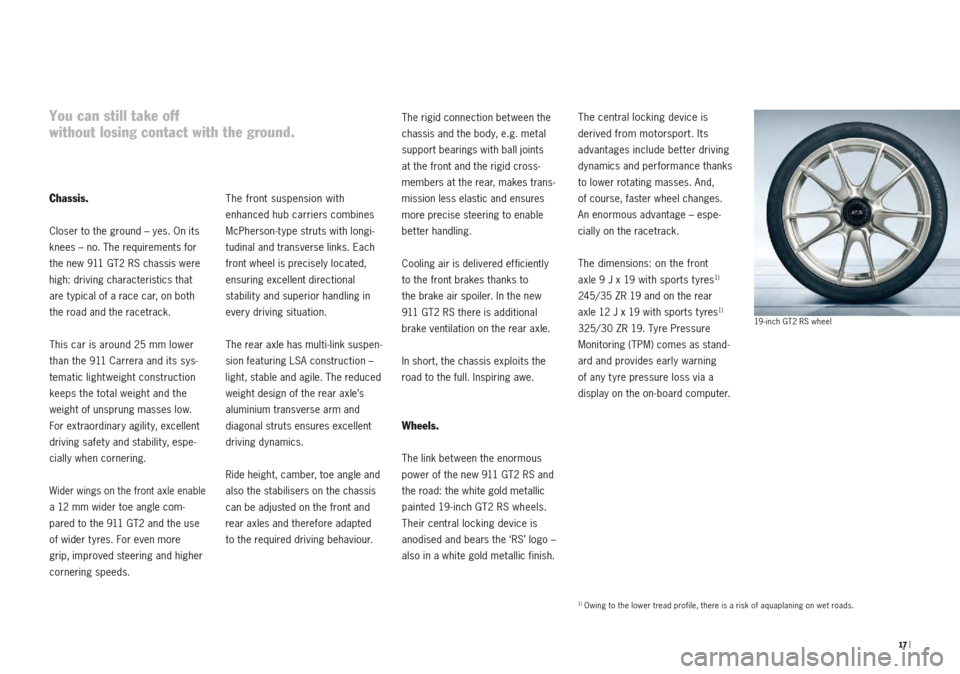
17 |
Chassis.
Closer to the ground – yes. On its
knees – no. The requirements for
the new 911 GT2 RS chassis were
high: driving characteristics that
are typical of a race car, on both
the road and the racetrack.
This car is around 25 mm lower
than the 911 Carrera and its sys-
tematic lightweight construction
keeps the total weight and the
weight of unsprung masses low.
For extraordinary agility, excellent
driving safety and stability, espe-
cially when cornering.
Wider wings on the front axle enable
a 12 mm wider toe angle com-
pared to the 911 GT2 and the use
of wider tyres. For even more
grip, improved steering and higher
cornering speeds.
The front suspension with
enhanced hub carriers combines
McPherson-type struts with longi-
tudinal and transverse links. Each
front wheel is precisely located,
ensuring excellent directional
stability and superior handling in
every driving situation.
The rear axle has multi-link suspen-
sion featuring LSA construction –
light, stable and agile. The reduced
weight design of the rear axle’s
aluminium transverse arm and
diagonal struts ensures excellent
driving dynamics.
Ride height, camber, toe angle and
also the stabilisers on the chassis
can be adjusted on the front and
rear axles and therefore adapted
to the required driving behaviour. The rigid connection bet ween the
chassis and the body, e.g. metal
support bearings with ball joints
at the front and the rigid cross-
members at the rear, makes trans-
mission less elastic and ensures
more precise steering to enable
better handling.
Cooling air is delivered efficiently
to the front brakes thanks to
the brake air spoiler. In the new
911 GT2 RS there is additional
brake ventilation on the rear axle.
In short, the chassis exploits the
road to the full. Inspiring awe.
Wheels.
The link between the enormous
power of the new 911 GT2 RS and
the road: the white gold metallic
painted 19-inch GT2 RS wheels.
Their central locking device is
anodised and bears the ‘RS’ logo –
also in a white gold metallic finish.
The central locking device is
derived from motorsport. Its
advantages include bet ter driving
dynamics and performance thanks
to lower rotating masses. And,
of course, faster wheel changes.
An enormous advantage – espe-
cially on the racetrack.
The dimensions: on the front
axle 9 J x 19 with sports tyres
1)
245/35 ZR 19 and on the rear
axle 12 J x 19 with sports tyres
1)
325/30 ZR 19. Tyre Pressure
Monitoring (TPM) comes as stand-
ard and provides early warning
of any tyre pressure loss via a
display on the on-board computer.
You can still take off
without losing contact with the ground.
19 -inch GT2 RS wheel
1) Owing to the lower tread profile, there is a risk of aquaplaning on wet roads.
Page 15 of 35
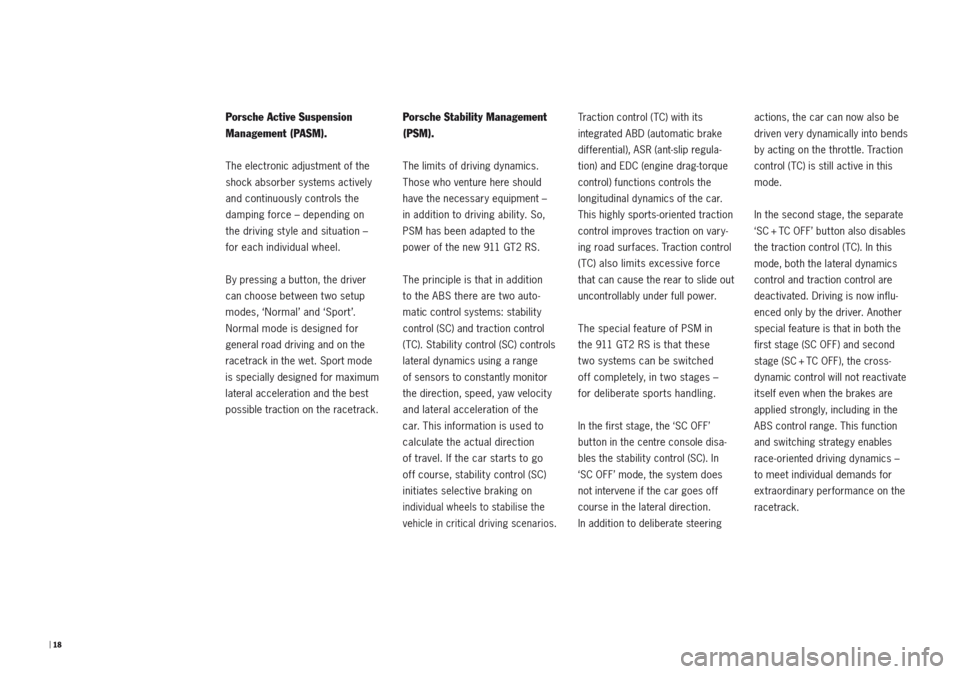
| 18
Porsche Active Suspension
Management (PASM).
The electronic adjustment of the
shock absorber systems actively
and continuously controls the
damping force – depending on
the driving style and situation –
for each individual wheel.
By pressing a button, the driver
can choose between two setup
modes, ‘Normal’ and ‘Sport ’.
Normal mode is designed for
general road driving and on the
racetrack in the wet. Sport mode
is specially designed for maximum
lateral acceleration and the best
possible traction on the racetrack.
Porsche Stability Management
(PSM).
The limits of driving dynamics.
Those who venture here should
have the necessary equipment –
in addition to driving ability. So,
PSM has been adapted to the
power of the new 911 GT2 RS.
The principle is that in addition
to the ABS there are
two auto-
matic control systems: stability
control (SC) and traction control
(TC). Stability control (SC) controls
lateral dynamics using a range
of sensors to constantly monitor
the direction, speed, yaw velocity
and lateral acceleration of the
car. This information is used to
calculate the actual direction
of travel. If the car starts to go
off course, stability control (SC)
initiates selective braking on
individual wheels to stabilise the
vehicle in critical driving scenarios.
Traction control (TC) with its
integrated ABD (automatic brake
differential), ASR (ant-slip regula-
tion) and EDC (engine drag-torque
control) functions controls the
l ongitudinal dynamics of the car.
This highly sports-oriented traction
control improves traction on vary-
ing road surfaces. Traction control
(TC) also limits excessive force
that can cause the rear to slide out
uncontrollably under full power.
The special feature of PSM in
the 911 GT2 RS is that these
two systems can be switched
of f completely, in t wo stages –
for deliberate sports handling.
In the first stage, the ‘SC OFF’
button in the centre console disa-
bles the stability control (SC). In
‘SC OFF’ mode, the system does
not intervene if the car goes off
course in the lateral direction.
In addition to deliberate steering actions, the car can now also be
driven very dynamically into bends
by acting on the throttle. Traction
control (TC) is still active in this
mode.
In the second stage, the separate
‘SC + TC OFF’ button also disables
the traction control (TC). In this
mode, both the lateral dynamics
control and traction control are
deactivated. Driving is now influ-
enced only by the driver. Another
special feature is that in both the
first stage (SC OFF) and second
stage (SC + TC OFF), the cross-
dynamic control will not reactivate
itself even when the brakes are
applied strongly, including in the
ABS control range. This function
and switching strategy enables
race-oriented driving dynamics –
to meet individual demands for
extraordinary performance on the
racetrack.
Page 22 of 35
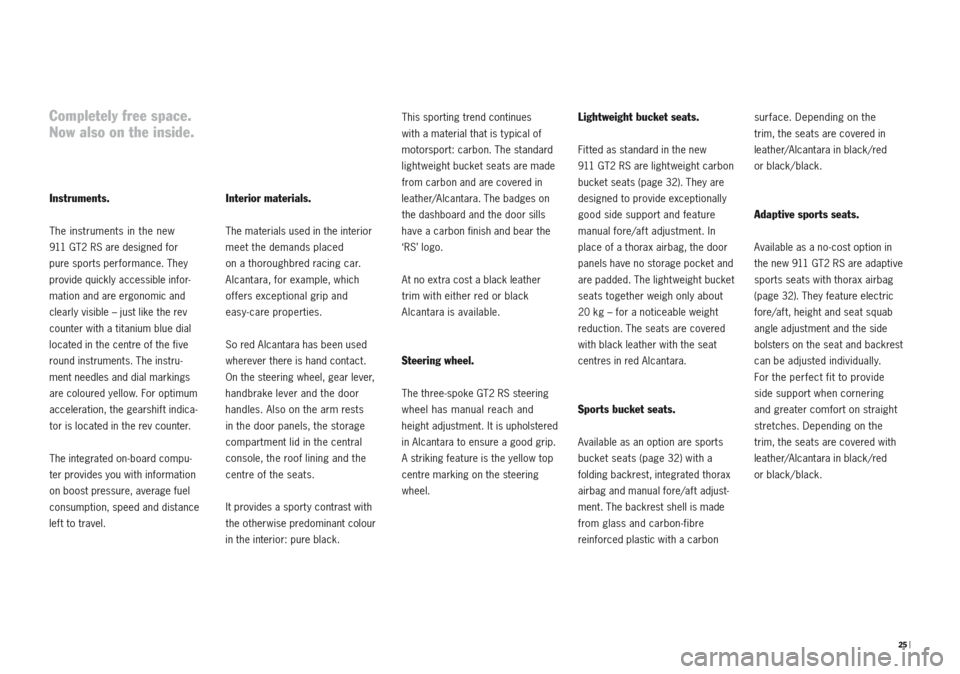
25 |
Instruments.
The instruments in the new
911 GT2 RS are designed for
pure sports performance. They
provide quickly accessible infor-
mation and are ergonomic and
clearly visible – just like the rev
counter with a titanium blue dial
located in the centre of the five
round instruments. The instru-
ment needles and dial markings
are coloured yellow. For optimum
acceleration, the gearshift indica-
tor is located in the rev counter.
The integrated on-board compu-
ter provides you with information
on boost pressure, average fuel
consumption, speed and distance
lef t to travel.
Interior materials.
The materials used in the interior
meet the demands placed
on a thoroughbred racing car.
Alcantara, for example, which
offers exceptional grip and
easy-care properties.
So red Alcantara has been used
wherever there is hand contact.
On the steering wheel, gear lever,
handbrake lever and the door
handles. Also on the arm rests
in the door panels, the storage
compartment lid in the central
console, the roof lining and the
centre of the seats.
It provides a sport y contrast with
the otherwise predominant colour
in the interior: pure black.This sporting trend continues
with a material that is typical of
motorsport: carbon. The standard
lightweight bucket seats are made
from carbon and are covered in
leather/Alcantara. The badges on
the dashboard and the door sills
have a carbon finish and bear the
‘RS’ logo.
At no extra cost a black leather
trim with either red or black
Alcantara is available.
Steering wheel.
The three-spoke GT2 RS steering
wheel has manual reach and
height adjustment. It is upholstered
in Alcantara to ensure a good grip.
A striking feature is the yellow top
centre marking on the steering
wheel.
Lightweight bucket seats.
Fit ted as standard in the new
911 GT2 RS are lightweight carbon
bucket seats (page 32). They are
designed to provide exceptionally
good side support and feature
manual fore/aft adjustment. In
place of a thorax airbag, the door
panels have no storage pocket and
are padded. The lightweight bucket
seats together weigh only about
20 kg – for a noticeable weight
reduction. The seats are covered
with black leather with the seat
centres in red Alcantara.
Sports bucket seats.
Available as an option are sports
bucket seats (page 32) with a
folding backrest, integrated thorax
airbag and manual fore/aft adjust-
ment. The backrest shell is made
from glass and carbon-fibre
reinforced plastic with a carbon
surface. Depending on the
trim, the seats are covered in
leather/Alcantara in black/red
or black/black.
Adaptive sports seats.
Available as a no-cost option in
the new 911 GT2 RS are adaptive
sports seats with thorax airbag
(page 32). They feature electric
fore/aft, height and seat squab
angle adjustment and the side
bolsters on the seat and backrest
can be adjusted individually.
For the perfect fit to provide
side support when cornering
and greater comfort on straight
stretches. Depending on the
trim, the seats are covered with
leather/Alcantara in black/red
or black/black.
Completely free space.
Now also on the inside.
Page 31 of 35
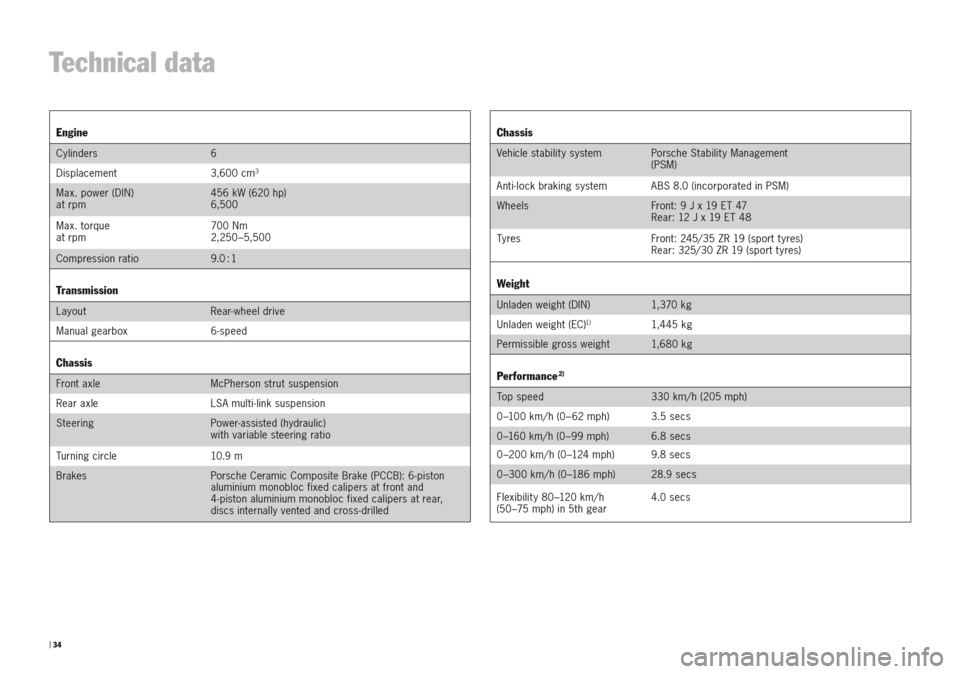
| 34
Technical data
Engine
Cylinders 6
Displacement 3,600 cm
3
Max. power (DIN)
at rpm 456 kW (620 hp)
6,500
Max. torque
at rpm 700 Nm
2,250 –5,500
Compression ratio 9.0 : 1
Transmission
Layout Rear-wheel drive
Manual gearbox 6-speed
Chassis
Front axle McPherson strut suspension
Rear axle LSA multi-link suspension
Steering Power-assisted (hydraulic)
with variable steering ratio
Turning circle 10.9 m
Brakes Porsche Ceramic Composite Brake (PCCB): 6-piston
aluminium monobloc fixed calipers at front and
4-piston aluminium monobloc fixed calipers at rear,
discs internally vented and cross-drilled
Chassis
Vehicle stability system Porsche Stability Management
(PSM)
Anti-lock braking system ABS 8.0 (incorporated in PSM)
Wheels Front: 9 J x 19 ET 47
Rear: 12 J x 19 ET 48
Tyres Front: 245/35 ZR 19 (sport t yres)
Rear: 325/30 ZR 19 (sport tyres)
Weight
Unladen weight (DIN) 1,370 kg
Unladen weight (EC)
1)1,4 45 k g
Permissible gross weight 1,680 kg
Performance2)
Top speed 330 km/ h (205 mph)
0–100 km/ h (0–62 mph) 3.5 secs
0–160 km/ h (0–99 mph) 6.8 secs
0–200 km/h (0–124 mph) 9.8 secs
0–300 km/h (0–186 mph) 28.9 secs
Flexibility 80–120 km/h
(50–75 mph) in 5th gear 4.0 secs
Page 32 of 35
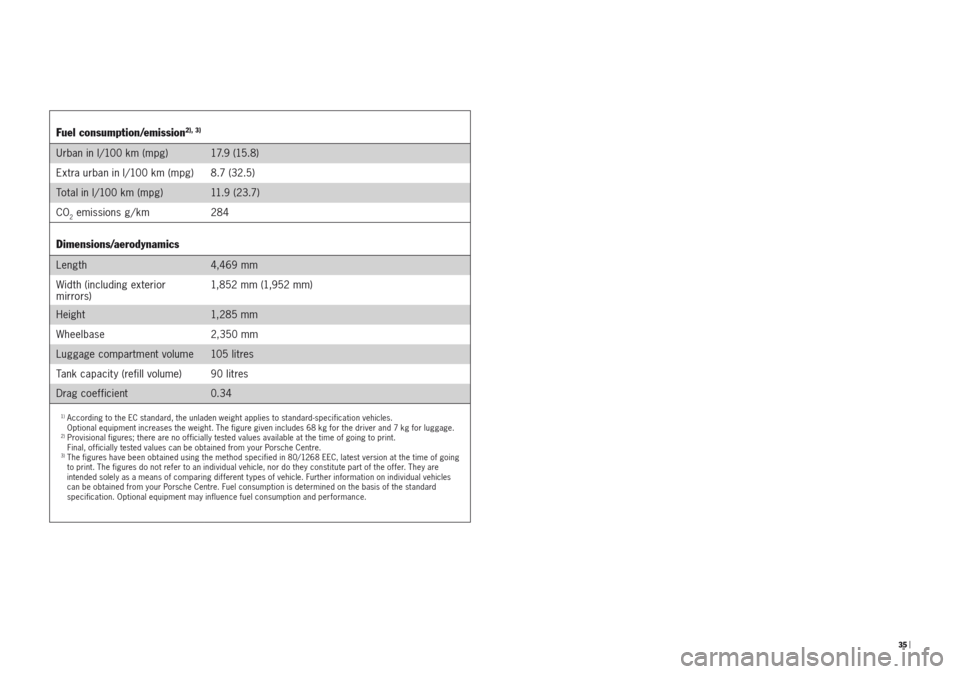
35 |
Fuel consumption/emission2), 3)
Urban in l/100 km (mpg) 17.9 (15.8)
Extra urban in l/100 km (mpg) 8.7 (32.5)
Total in l/100 km (mpg) 11.9 (23.7)
CO
2 emissions g/km 284
Dimensions/aerodynamics
Length 4,469 mm
Width (including exterior
mirrors) 1,852 mm (1,952 mm)
Height 1,285 mm
Wheelbase 2,350 mm
Luggage compartment volume 105 litres
Tank capacity (refill volume) 90 litres
Drag coefficient 0.34
1) According to the EC standard, the unladen weight applies to standard -specification vehicles.
Optional equipment increases the weight. The figure given includes 68 kg for the driver and 7 kg for luggage.
2) Provisional figures; there are no of ficially tested values available at the time of going to print.
Final, of ficially tested values can be obtained from your Porsche Centre.
3) The figures have been obtained using the method specified in 80/1268 EEC, latest version at the time of going
to print. The figures do not refer to an individual vehicle, nor do they constitute part of the of fer. They are
intended solely as a means of comparing dif ferent t ypes of vehicle. Further information on individual vehicles
can be obtained from your Porsche Centre. Fuel consumption is determined on the basis of the standard
specification. Optional equipment may influence fuel consumption and performance.